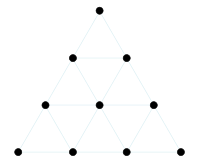The graves of Pico della Mirandola and Angelo Poliziano at the church of San Marco, Florence. Below a statue of Girolamo Savonarola.
From Saint Paul (actually Pseudo-Dionysius, who in that time was generally taken to be Dionysius the judge of Athens who was converted by Saint Paul in Acts 17:34[1]) Pico takes his cue on the activity of the cherubim who are purged and illuminated prior to being perfected. Continuing, he recounts the dream that the patriarch Jacob had of the ladder to heaven, with angels moving up and down its steps, while on the run from his brother Esau. If we want to be able to tread on this ladder, Pico says, we have to make sure we are pure, because it is sacrilege to touch that which is holy with dirty feet or unwashed hands. So first, we have to purge ourselves of moral impurities like base desires and sensual passions through the study of moral philosophy. Second, to be able to move freely to and from the various rings of existence, we have to dispel our ignorance and train our sense of reason to properly recognize truth and deception through dialectic. Third, we have to study natural philosophy, in order to come to a closer understanding of the wonders of nature and the workings of God. This is an important step, because at the heart of religion is the “assiduous contemplation of the wonders of God.” Finally, after completing these three steps one is fully prepared for theology, the knowledge of divine things, which in turn will lead to ultimate peace by way of the annihilation of the one in the eternal Source of all existence.
Pico thus proposes a regimen that mirrors the Cherubic way of life, purifying, illuminating and perfecting the human soul, and eventually mimics the Seraphic state of being, namely total consummation in the Godhead. The goal for Pico is the Kabbalistic “death of the kiss”, an ecstatic state whereby the soul has freed itself of its material bonds and becomes one with immaterial nature.
Now what were the practical ways of achieving this? The easy answer would be to study copiously everything that Pico had done, as the clarification of his methods aims for a large part at its subsequent justification. In fact, there is already an important dimension to be found in the quadripartite division of Pico’s curriculum. Such a fourfold structure recalls the Pythagorean tetractys, a triangular figure consisting of ten dots spread across four rows, descending (or ascending) from four to three to two to one, and a cosmic symbol of considerable spiritual power. The figure of the tetractys can become an important medium for contemplative practice or an amulet of magical power when infused with numerological exercises and juggling with Hebrew letters, pet subjects of the Kabbalah. Hebrew, as the original language of the Bible and by extension God, is therefore the proper instrument through which this kind of natural magic should be conducted. Here the allure of Kabbalah to Pico starts to become clear: letters, words, phrases and numbers are at the core of this mystical tradition, and since every letter of the Hebrew alphabet has a numerological value, the potential to derive hidden meanings from Scripture by calculating the arithmetic of holy names and utterances becomes virtually limitless.
Example of a "tetractys"
Devotees of the Kabbalah considered Hebrew letters to be the roots of the universe (in the end, it is through speech that everything is created in Genesis 1), and so their alterations and interchangeability with each other and the names of God was a prime ritual of meditative ecstasy. Moreover, in Pico’s day many Christians were concerned with words and meanings as they were found in the Bible. Biblical language was thought to not only work in a descriptive way, but also as the grounds on which the reality of things was built: words signified the objects that they were.
For Jews the most holy name of God was the Tetragrammaton (YHWH), strictly forbidden to be uttered and consisting of the letters yodh (י), he (ה), waw (ו), he. These letters corresponded respectively to the numerical values of 10, 5, and 6, thus giving a total value of the name as 26. However, such simple arithmetic did not sufficiently satisfy the mystic and to cumulatively add the numbers (10 (yodh) +10+5 (yodh & he), and so on), carried even more spiritual power, yielding the total of 72, which related to the number of letters that made up the true name of God and which only the most skilled Kabbalist could hope to discover . Going further still, to represent the letters in the tetractys splendidly confirmed the sacred unity of the name. Putting yodh at the first four points results in 40 (10+10+10+10), he at the second three in 15, waw at the third row of two in 12 and he again at the last point simply makes up 5. Adding these together then, amounted again to 72. Cue divine frenzy and spiritual illumination.
Tetractys with the Tetragrammaton. Man, did you wish you had payed better attention to what I wrote instead of just glaring at the pretty pictures.
Still hanging in there? I’m wrapping this one up pretty soon so that you can begin to bathe in the heavenly glory of my unimaginable (save by he who has experienced the proper mode of spiritual electrifying illumination; you know, like John Travolta...) brilliance post-haste!



No comments:
Post a Comment